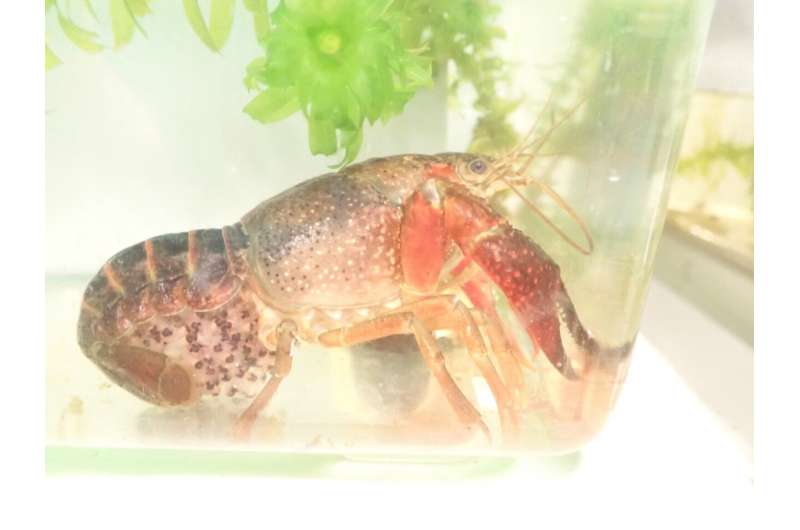This article has been reviewed according to Science X's editorial process and policies. Editors have highlighted the following attributes while ensuring the content's credibility:
fact-checked
trusted source
proofread
Unveiling the reproductive secrets of red-swamp crayfish

Procambarus clarkii is a crustacean species native to American freshwater bodies. Brought to Japan in the 1920s as a feed for frogs, this crustacean has slowly taken over the Japanese freshwaters by predation and propagation. In fact, in 2023, the red-swamp crayfish was designated as an invasive alien species by the Japanese Ministry of the Environment and of the Agriculture, Forestry and Fisheries.
One way to control the growth in population of red-swamp crayfish and the accompanying crisis is to capture the red-swamp crayfish in their reproductive form. To this end, however, it is essential to understand their reproductive characteristics, including their anatomical alterations. However, little is known about the reproductive biology of P. clarkii, not only in Japan, but also in their habitats elsewhere around the world.
To address this research gap, researchers led by Professor Kazuyoshi Nakata of Okayama University, recently studied several reproduction aspects and morphological characteristics of the red-swamp crayfish. Mr. Quang-Tuong Luong, Ms. Rika Shiraishi, and Dr. Koki R. Katsuhara were also a part of this study, which was published in the Journal of Crustacean Biology.
To undertake this study, the researchers first collected the red-swamp crayfish over a span of one year, from November 2015 to November 2016, from a local pond in Okayama, western Japan. They collected and observed a total of 6,319 crayfish, comprising 2,601 males and 2,777 females, with eight unknown sex and 933 juveniles.
Red-swamp crayfish have four growth stages—eggs, hatchlings, juveniles, and adults. Adults alternate from being in a sexually active form (Form I) to a sexually inactive form (Form II).
In the breeding season that peaks in autumn, it was observed that males in Form I had enlarged chelae, or the claw-shaped structures that crustaceans utilize for defense and capturing prey. By identifying this characteristic, this study is the first to highlight that hook length is an important indicator of sexual status in red-swamp crayfish.
Hooks are the sharp horn-like extensions present on the third and fourth feet of the red-swamp crayfish. Most importantly, hooks are used by the males to secure the females in the mating position. It was visibly larger in Form I males than in Form II males.
Confirming their observation, Prof. Nakata from the Faculty of Environmental, Life, Natural Science and Technology, Okayama University, Japan, says, "Our results indicate that both chelae and hook length in males significantly differed among Form I and Form II, revealing chelae or hook length to be an important identifier for Form I or II males of P. clarkii."
Moreover, the results also clarified that the invasive red-swamp crayfish P. clarkii shows a high reproductive ability and a fast growth rate compared to the Japanese native crayfish C. japonicus. It was observed that the female red-swamp crayfish could carry as many as 100 to 375 eggs per individual, whereas the Japanese native crayfish could carry only about 18 to 75 eggs.
In red-swamp crayfish, even though the optimum temperature for egg hatching was found to be 25 °C, egg hatching could occur at temperatures as low as 7 °C.
Prof. Nakata explains these findings, "From this temperature value, it was possible to estimate the spawning date for juveniles. Moreover, the hatching dates and the time juveniles leave the females can also be calculated." While the native Japanese crayfish takes approximately five years to reach reproductive age, the red-swamp crayfish invasive species reaches this age in the fastest case within just five months of hatching, which explains the fast growth rate of this highly invasive species.
Going ahead, these findings will contribute to promoting effective control of the invasive populations of P. clarkii and aid in the conservation of biodiversity in freshwater areas worldwide.
More information: Quang-Tuong Luong et al, Reproductive biology of the introduced red-swamp crayfish Procambarus clarkii (Girard, 1852) (Decapoda: Astacidea: Cambaridae) in western Japan, Journal of Crustacean Biology (2023). DOI: 10.1093/jcbiol/ruad063
Provided by Okayama University


















